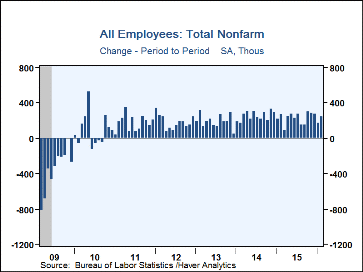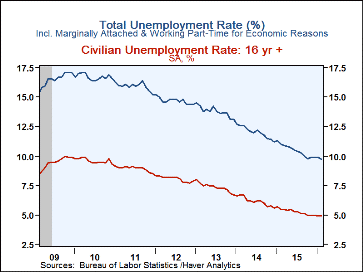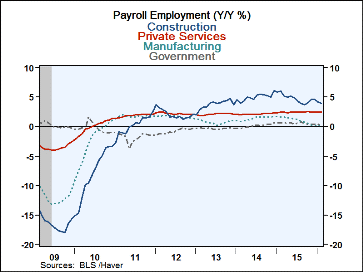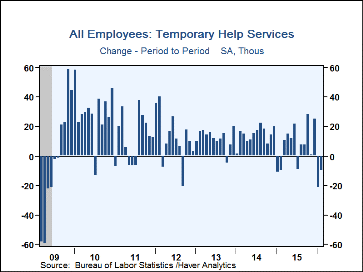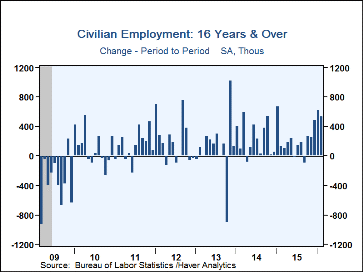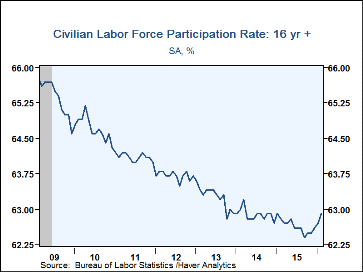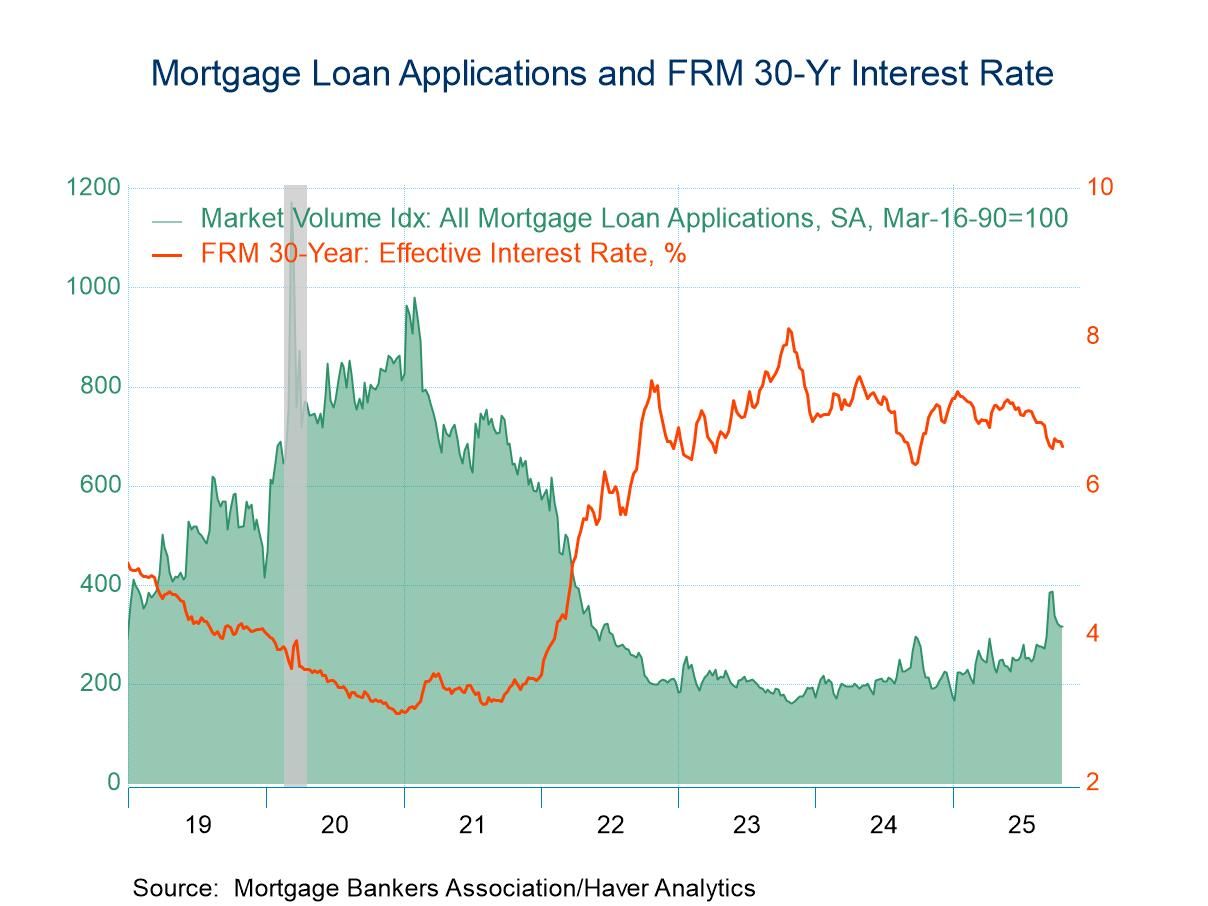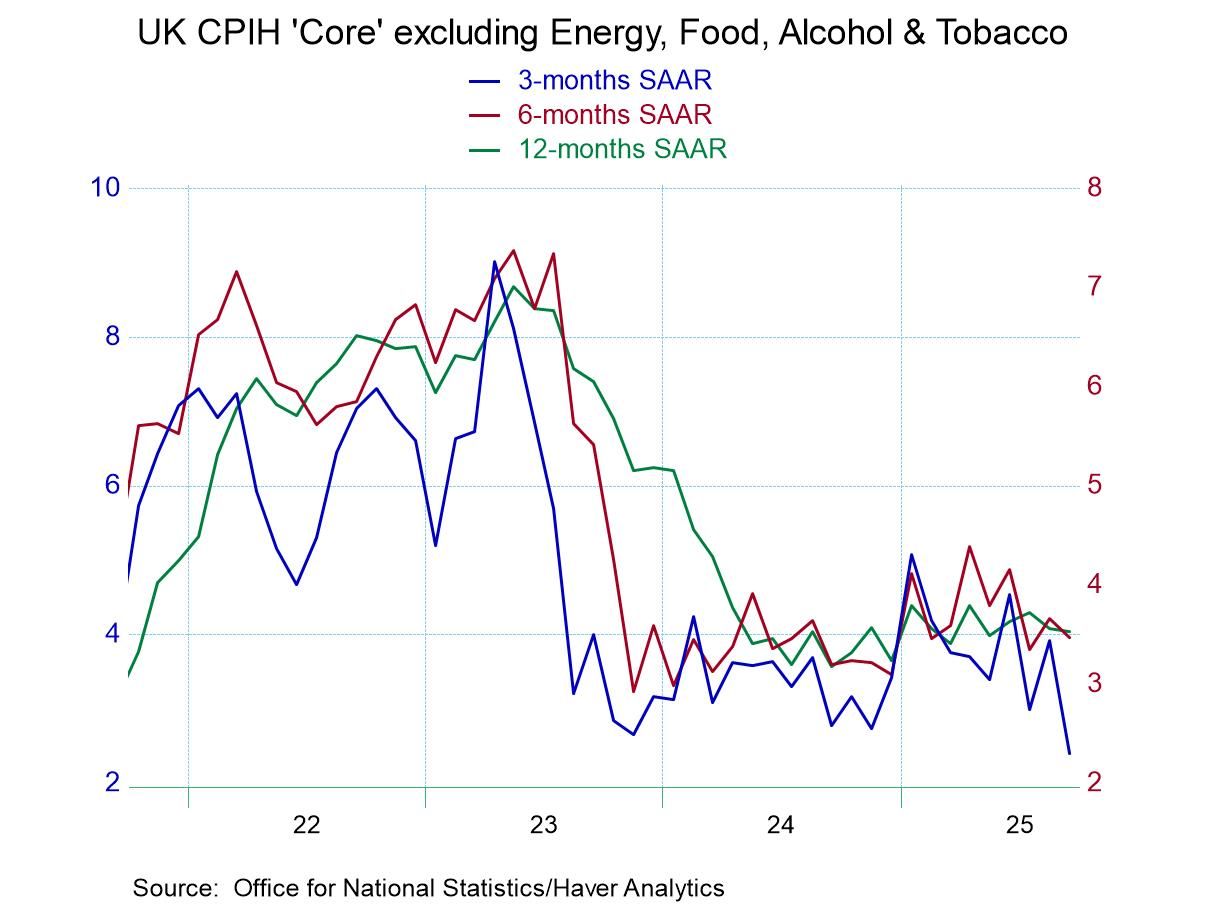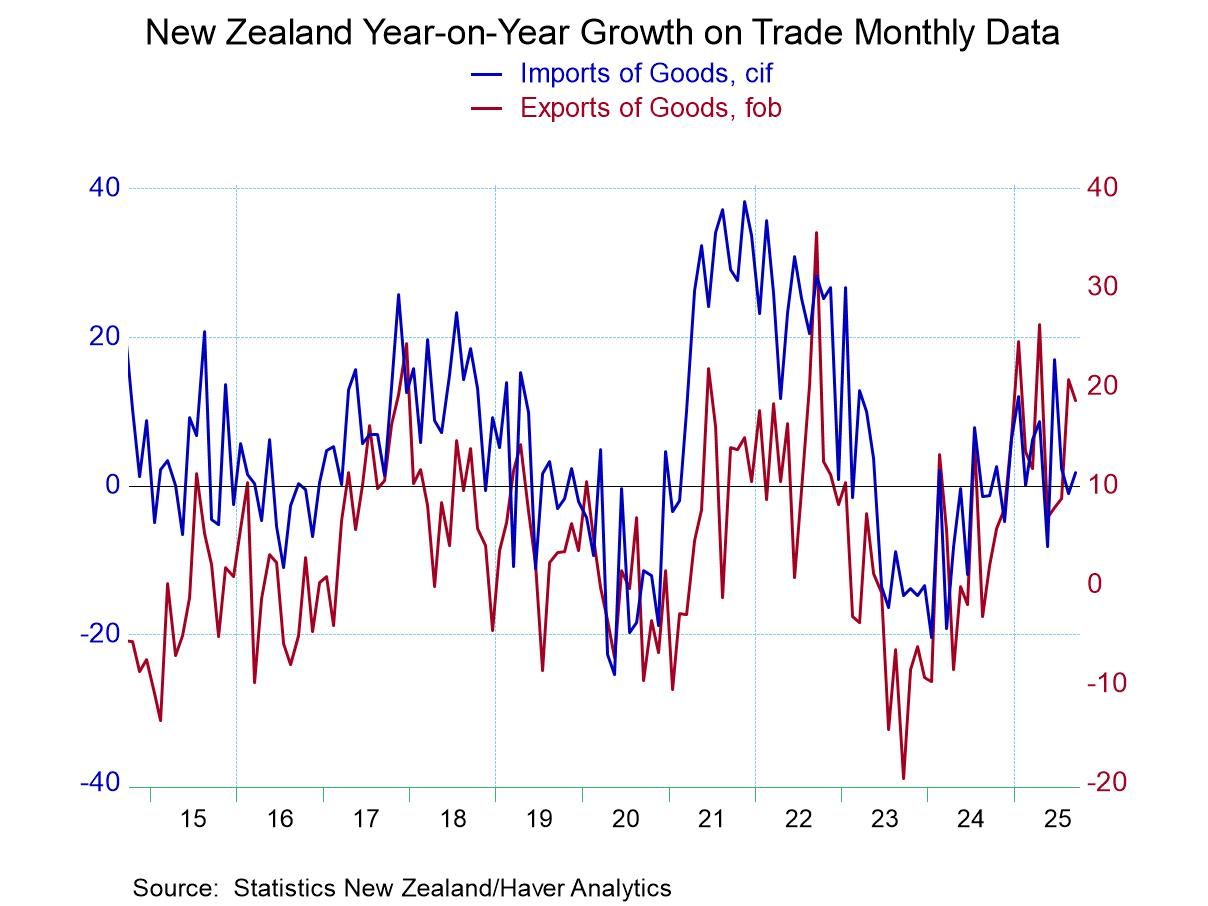 Global| Mar 04 2016
Global| Mar 04 2016U.S. Payrolls Increase Above Expectations; Jobless Rate Is Unchanged; Earnings Dip
by:Tom Moeller
|in:Economy in Brief
Summary
The job market firmed during February. Payroll employment increased by 242,000 after slowing in January, while the unemployment held steady at 4.9%, its lowest level since February 2008. The overall unemployment rate including [...]
The job market firmed during February. Payroll employment increased by 242,000 after slowing in January, while the unemployment held steady at 4.9%, its lowest level since February 2008. The overall unemployment rate including marginally-attached and those working part-time for economic reasons, fell to 9.7%. Job market improvement did not translate, however, into increased earnings. Average hourly earnings eased 0.1%, the first meaningful decline since December 2014. A 195,000 payroll employment increase had been expected in the Action Economics Forecast Survey and a 4.9% jobless rate was forecasted. Average hourly earnings were expected to rise 0.2%.
From the payroll employment survey, the 242,000 increase in employment last month followed gains of 172,000 and 271,000 during January & December, revised up by a collective 30,000. A 19,000 increase (4.2% y/y) in construction jobs followed a 15,000 January increase. These gains compared to a 25,000 monthly average during 2015. Factory sector employment fell 16,000 (+0.2% y/y), its first monthly decline since September. Mining jobs were off 19,200 (-17.6% y/y), continuing the decline which began in October 2014, and now totals 192,100 or 22.3%.
Private service sector employment increased 245,000, the strongest increase since October. The rise was led by a 54,900 gain (2.3% y/y) in retail trade employment which followed a 62,100 increase. Leisure & hospitality industry employment followed with a 48,000 increase (3.0% y/y), which came on the heels of a 45,000 rise. Employment in education rose 28,200 (1.9% y/y) and made up January's 19,500 fall. Professional & business services jobs improved 23,000 (3.2% y/y) after a 15,000 increase, but these gains were down from last year's monthly average of 51,000. Temporary help employment fell 9,800 (+3.1% y/y) after a 21,700 decline in January. Jobs in information services gained 12,000 (1.6% y/y) following a 4,000 improvement, and financial industry jobs rose 6,000 (1.8% y/y) after a 16,000 increase.
Public sector employment increased 12,000 (0.3% y/y) and made up a 10,000 decline during the prior month. Federal government jobs rose 5,000 (0.9% y/y) after a 4,000 decline. State government employment offset this gain with a 5,000 drop (-0.4% y/y), the fourth consecutive monthly decline. Local government employment rose 12,000 (0.5% y/y) after a 15,000 increase.
Average weekly hours worked dropped to 34.4, the lowest level in two years. Mining & logging hours fell sharply to 42.9 versus a 45.7 high in March 2014 and factory sector hours of 40.8 were down from the 41.1 hour high in November 2014. Private service sector hours eased to 33.3 from the cycle peak of 33.4, reached first in March 2013. Financial industry hours remained high at 37.6, but hours in the information sector returned to a cycle low of 36.0, down from 36.9 in early 2014. Leisure & hospitality hours fell to 26.1 from a 26.4 high reached one year earlier. Aggregate hours worked (employment times hours) reversed its January rise and left the Q1'16 average up 1.9% (AR) versus Q4'15.
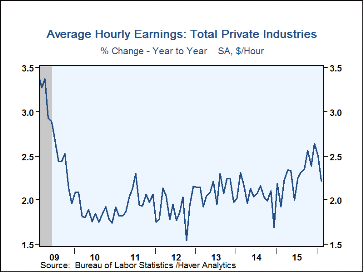 Average hourly earnings eased 0.1%, lowering the y/y
increase to 2.2%, down from the 2.6% high in December. Mining & logging
earnings fell 0.6% (+2.0% y/y) and factory sector earnings eased 0.1% (+2.2%
y/y). Information industry earnings strengthened 0.5% (4.6% y/y), but financial
sector earnings were off 0.4% (+2.4% y/y).
Average hourly earnings eased 0.1%, lowering the y/y
increase to 2.2%, down from the 2.6% high in December. Mining & logging
earnings fell 0.6% (+2.0% y/y) and factory sector earnings eased 0.1% (+2.2%
y/y). Information industry earnings strengthened 0.5% (4.6% y/y), but financial
sector earnings were off 0.4% (+2.4% y/y).
From the household employment survey, the unemployment rate remained stable at 4.9% as employment rose 530,000 (1.9% y/y) and the labor force increased 555,000 (1.3% y/y). A better job market is encouraging individuals to rejoin the labor force. As the population grew 0.1% (1.1% y/y) in February, the labor force participation rate increased to 62.9%. That's up from the September low of 62.4% and the highest level since January of 2015. Potential workers not in the labor force fell for the fifth straight month. The teenage participation rate of 35.0% was up from 33.6% six months ago. The rate for individuals 25 and over rose to 64.1% versus the September low of 63.8%.
The average duration of unemployment increased to 29.0 weeks, up from the September low of 26.3 weeks. The median duration of 11.2 weeks was down, however, and remained near its cycle low.
The unemployment rate for individuals without a high school diploma of 7.3% compared to 5.3% for those with one, but no college. Individuals with some college but not a bachelors degree saw 4.2% unemployment while the unemployment rate for college graduates remained at 2.5%, where it's been since June.
Rules of Engagement from the Federal Reserve Bank of San Francisco can be found here.
The labor market data is contained Haver's USECON database. Detailed figures are in the EMPL and LABOR databases. The expectations figure is in the AS1REPNA database.
| Employment: (SA, M/M Change, 000s) | Feb | Jan | Nov | Jan Y/Y | 2015 | 2014 | 2013 |
|---|---|---|---|---|---|---|---|
| Payroll Employment | 242 | 172 | 271 | 1.9% | 2.1% | 1.9% | 1.6% |
| Previous | -- | 151 | 262 | -- | -- | -- | -- |
| Manufacturing | -16 | 23 | 6 | 0.2 | 1.1 | 1.4 | 0.8 |
| Construction | 19 | 15 | 48 | 4.2 | 4.8 | 5.0 | 3.7 |
| Private Service-Producing | 245 | 113 | 215 | 2.5 | 2.5 | 2.1 | 2.1 |
| Government | 12 | -10 | 12 | 0.3 | 0.5 | 0.0 | -0.3 |
| Average Weekly Hours - Private Sector | 34.4 | 34.6 | 34.5 | 34.6 (Feb.'15) |
34.5 | 34.5 | 34.5 |
| Private Sector Average Hourly Earnings (%) | -0.1 | 0.5 | -0.0 | 2.2 | 2.3 | 2.1 | 2.1 |
| Unemployment Rate (%) | 4.9 | 4.9 | 5.0 | 5.5 (Feb.'15) |
5.3 | 6.2 | 7.4 |
Tom Moeller
AuthorMore in Author Profile »Prior to joining Haver Analytics in 2000, Mr. Moeller worked as the Economist at Chancellor Capital Management from 1985 to 1999. There, he developed comprehensive economic forecasts and interpreted economic data for equity and fixed income portfolio managers. Also at Chancellor, Mr. Moeller worked as an equity analyst and was responsible for researching and rating companies in the economically sensitive automobile and housing industries for investment in Chancellor’s equity portfolio. Prior to joining Chancellor, Mr. Moeller was an Economist at Citibank from 1979 to 1984. He also analyzed pricing behavior in the metals industry for the Council on Wage and Price Stability in Washington, D.C. In 1999, Mr. Moeller received the award for most accurate forecast from the Forecasters' Club of New York. From 1990 to 1992 he was President of the New York Association for Business Economists. Mr. Moeller earned an M.B.A. in Finance from Fordham University, where he graduated in 1987. He holds a Bachelor of Arts in Economics from George Washington University.


